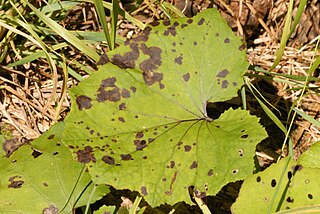
Leaf vegetables, also called leafy greens, pot herbs, vegetable greens, or simply greens, are plant leaves eaten as a vegetable, sometimes accompanied by tender petioles and shoots. Leaf vegetables eaten raw in a salad can be called salad greens.

Erysiphe betae is a fungal plant pathogen. It is a form of powdery mildew that can affect crops of sugar beet, that could cause up to a 30% yield loss. The fungus occurs worldwide in all regions where sugar beet is grown and it also infects other edible crops, e.g. beetroot.

Pythium debaryanum is a species of water mould in the family Pythiaceae. It is known as a plant pathogen on many kinds of wild and cultivated plants, including peanut, beet, eucalyptus, tobacco, and pine trees. The plants develop damping off, a disease state.

Cercospora beticola is a fungal plant pathogen which typically infects plants of the genus Beta, within the family of Chenopodiaceae. It is the cause of Cercospora leaf spot disease in sugar beets, spinach and swiss chard. Of these hosts, Cercospora leaf spot is the most economically impactful in sugar beets. Cercospora beticola is a deuteromycete fungus that reproduces using conidia. There is no teleomorph stage. C. beticola is a necrotrophic fungus that uses phytotoxins specifically Cercospora beticola toxin (CBT) to kill infected plants. CBT causes the leaf spot symptom and prevents root formation. Yield losses from Cercospora leaf spot are around 20 percent.

Ramularia brunnea is a fungal plant pathogen infecting strawberries. It was first described scientifically by American mycologist Charles Horton Peck.
Ramularia coryli is a fungal plant pathogen infecting hazelnuts.
Ramularia cyclaminicola is a fungal plant pathogen infecting cyclamens.
Ramularia macrospora is a fungal plant pathogen infecting bellflowers.
Ramularia menthicola is a fungal plant pathogen infecting mint.
Ramularia necator is a fungal plant pathogen infecting coconut palms.

Ramularia primulae is a fungal plant pathogen infecting Primula. Its primary host is Primula veris.
Ramularia spinaciae is a fungal plant pathogen infecting spinach.
Fusarium oxysporum f.sp. betae is a destructive fungal plant pathogen. It causes Fusarium yellows or fusarium wilt, characterized by yellowing and dwarfing.
Physoderma leproides is a plant pathogen infecting beets.
Cercospora apiicola is a fungal plant pathogen, who causes leaf spot on celery.

Mycosphaerella is a genus of ascomycota. With more than 10,000 species, it is the largest genus of plant pathogen fungi.

Uromyces is a genus of rust fungi in the family Pucciniaceae. The genus was described by Franz Unger in his 1833 work Die Exantheme der Pflanzen. They have a worldwide distribution but large occurrences happen in North America and Europe.

Ramularia is a genus of ascomycete fungi. Its species, which are anamorphs of the genus Mycosphaerella, are plant pathogens. Economically important host species include Narcissus, sugar beet, and barley.
Ramularia vallisumbrosae is a fungal plant pathogen infecting daffodils (Narcissus), causing narcissus white mould disease.

Ramularia ulmariae is a fungal species described by Cooke in 1876. Ramularia ulmariae belongs to the genus Ramularia and the family Mycosphaerellaceae. No subspecies are listed in the Catalog of Life.









